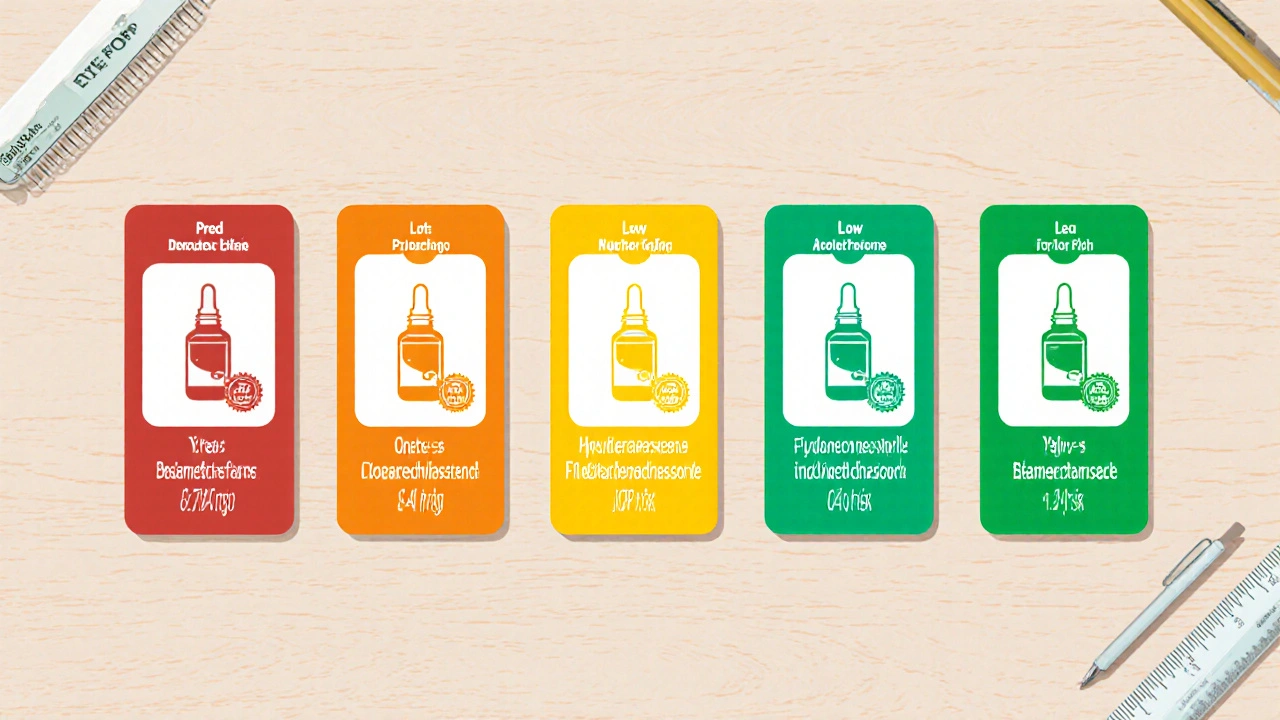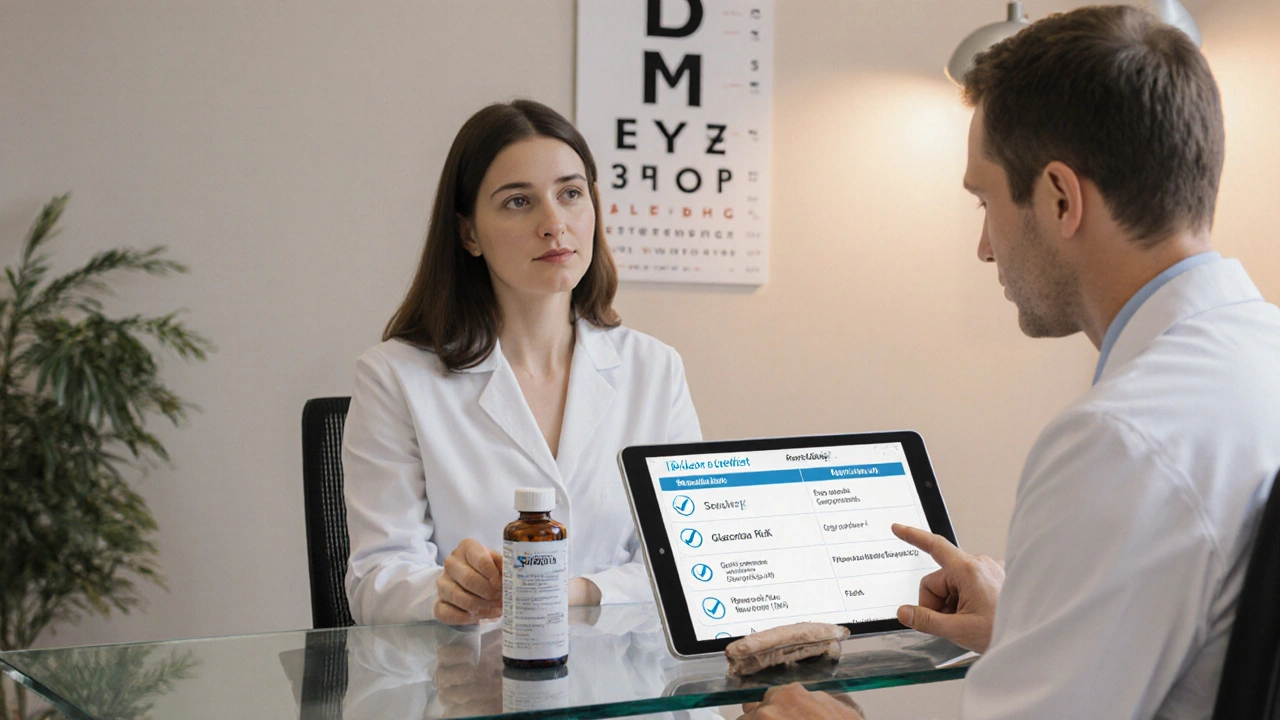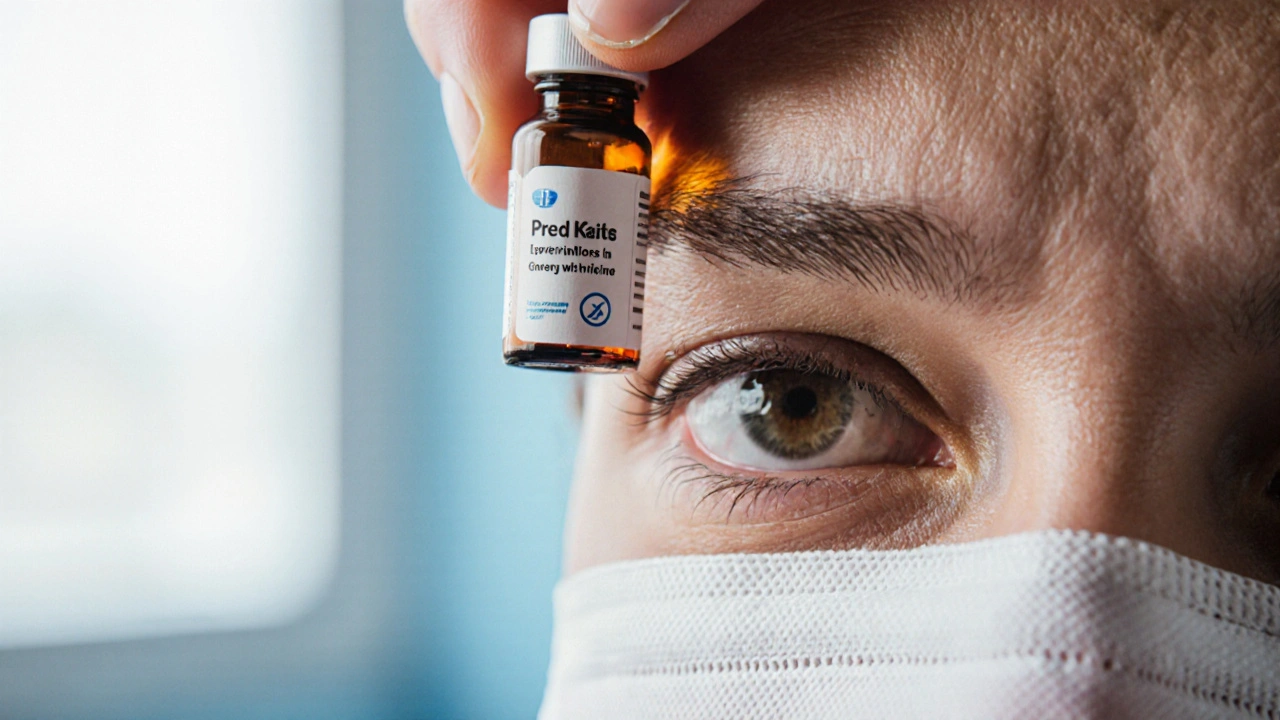Steroid Eye Drop Comparison Tool
Pred Forte
High Potency1% prednisolone acetate
1-2 hour onset
Dexamethasone
Very High Potency0.1% or 0.05%
Fast clearance
Loteprednol
Moderate Potency0.5%
Low IOP risk
Fluorometholone
Mid Potency0.1%
Mild uveitis
Hydrocortisone
Low Potency0.5%
Minimal side effects
Betamethasone
High Potency0.1%
Severe conditions
Comparison Results
Select a steroid eye drop above to view detailed comparison with Pred Forte.
When you or someone you care for needs fast relief from eye inflammation, the choice of eye drop can feel overwhelming. Pred Forte is a prescription‑strength prednisolone acetate ophthalmic suspension that’s been a go‑to for decades. But newer formulations and lower‑potency steroids promise fewer side‑effects and comparable efficacy. This guide breaks down the most common alternatives, weighs the pros and cons, and helps you decide which drop fits your situation best.
Why Pred Forte Became the Benchmark
Pred Forte (prednisolone acetate 1%) earned its reputation because it delivers strong anti‑inflammatory action with a well‑understood safety profile. It’s typically prescribed for post‑surgical inflammation, uveitis, and severe allergic conjunctivitis. The drug works by binding to glucocorticoid receptors in ocular tissues, suppressing cytokine release, and stabilising cell membranes.
- Potency: High (equivalent to systemic prednisolone 5‑10mg)
- Onset: 1-2hours
- Typical regimen: 1-4 drops daily, tapering over 2-4weeks
- Common side‑effects: Increased intra‑ocular pressure (IOP), cataract formation with long‑term use, temporary stinging
Because of its strength, doctors often reserve Pred Forte for cases where inflammation is aggressive or where a rapid response is critical.
Popular Alternatives and Their Core Characteristics
Below are the top five steroid eye drops that patients encounter as alternatives to Pred Forte.
Dexamethasone (0.1% or 0.05%) - a synthetic corticosteroid with potency roughly 5‑10times that of prednisolone. It’s favored for short‑term post‑operative use because it clears quickly from the eye.
Loteprednol etabonate (0.5%) - marketed as a “soft‑steroid.” Its molecular structure allows rapid de‑esterification, meaning strong anti‑inflammatory effects with a lower risk of IOP spikes.
Fluorometholone (0.1%) - a mid‑potency steroid that sits between prednisolone and loteprednol in terms of strength. It’s commonly used for allergic conjunctivitis and mild uveitis.
Hydrocortisone acetate (0.5%) - the weakest corticosteroid available for ocular use. It’s ideal for very mild irritation or for patients with a history of steroid‑induced glaucoma.
Betamethasone sodium phosphate (0.1%) - a high‑potency steroid often reserved for severe cases of scleritis or for patients who have not responded to other agents.

Side‑Effect Profile: What Sets Each Drug Apart
While all ocular steroids carry a risk of raising IOP, the magnitude varies.
- Pred Forte: IOP rise in 15‑20% of patients after 2‑3weeks of continuous use.
- Dexamethasone: Slightly lower IOP risk (≈10%) but can cause corneal epithelial thinning with prolonged use.
- Loteprednol: IOP increase in <5% of patients, making it the safest choice for glaucoma‑prone individuals.
- Fluorometholone: Moderate IOP risk (≈12%) and a mild cataract‑forming potential over long periods.
- Hydrocortisone: Minimal IOP impact (<2%) but also weaker anti‑inflammatory power.
- Betamethasone: Highest IOP surge risk (≈25%) and notable cataract acceleration.
Choosing the right drop often means balancing potency against the patient’s ocular health history.
Cost and Accessibility in 2025
Price can be a deciding factor, especially for long‑term therapy.
| Attribute | Pred Forte | Dexamethasone | Loteprednol | Fluorometholone | Hydrocortisone |
|---|---|---|---|---|---|
| Potency | High | Very High | Medium‑Low | Medium | Low |
| Typical dosage (drops/day) | 1‑4 (taper) | 1‑3 (taper) | 1‑2 (short course) | 2‑4 (taper) | 4‑6 (as needed) |
| Duration of action | 24‑36hrs | 12‑18hrs | 8‑12hrs | 10‑14hrs | 6‑10hrs |
| IOP risk | Moderate‑High | Low‑Moderate | Low | Moderate | Very Low |
| Average price (30‑ml bottle) | $45 | $38 | $52 | $40 | $30 |
| Prescription status (2025 AU) | Prescription‑only | Prescription‑only | Prescription‑only | Prescription‑only | Over‑the‑counter (some pharmacies) |
Decision Checklist: Which Steroid Eye Drop Suits You?
- Severe post‑surgical inflammation or uveitis? Choose a high‑potency option like Pred Forte or Betamethasone.
- History of glaucoma or steroid‑responsive IOP spikes? Loteprednol is the safest bet.
- Need a short‑term burst (≤1week) after minor procedures? Dexamethasone offers rapid clearance.
- Cost‑sensitive or need over‑the‑counter availability? Hydrocortisone provides the lowest price point.
- Allergic conjunctivitis with mild irritation? Fluorometholone balances potency and safety.
Always discuss these points with your ophthalmologist; they’ll tailor the regimen to your eye health, age, and how you respond to steroids.

Practical Tips for Using Steroid Eye Drops Safely
- Wash hands thoroughly before each drop.
- Pull down the lower eyelid to create a small pocket.
- Instil the drop without touching the tip to the eye or lashes.
- Close eyes gently for 30 seconds; press the inner corner (nasolacrimal duct) to reduce systemic absorption.
- Schedule IOP checks after two weeks of continuous use, especially with high‑potency drops.
- If you notice blurred vision, halos, or eye pain, stop the medication and contact your doctor immediately.
Next Steps & Troubleshooting
If you’re already on Pred Forte and experiencing side effects, don’t abruptly stop the drops. Your doctor may taper the dose over several weeks or switch you to a softer steroid like Loteprednol. For patients who can’t tolerate any steroid, non‑steroidal anti‑inflammatory drops (e.g., ketorolac) or oral NSAIDs can be adjuncts, though they work slower.
In rare cases where inflammation persists despite maximal steroid therapy, immunosuppressive agents (e.g., methotrexate) may be considered-always under specialist supervision.
Frequently Asked Questions
What conditions is Pred Forte usually prescribed for?
Pred Forte is most commonly used after eye surgery (cataract, vitrectomy), for acute anterior uveitis, severe allergic conjunctivitis, and ocular trauma where rapid inflammation control is needed.
How does Loteprednol compare to Pred Forte in terms of safety?
Loteprednol’s “soft‑steroid” design means it is less likely to raise intra‑ocular pressure (<5% risk) compared with Pred Forte’s 15‑20% risk. It is therefore preferred for patients with glaucoma or a family history of steroid‑induced IOP spikes.
Can I use over‑the‑counter hydrocortisone eye drops instead of a prescription steroid?
Hydrocortisone is much weaker and only suitable for mild irritation. It won’t control the inflammation seen after surgery or in uveitis, so it’s not a direct substitute for Pred Forte in those cases.
How long should I stay on Pred Forte before tapering?
Typical treatment lasts 2‑4weeks, with a gradual taper to avoid rebound inflammation. Your ophthalmologist will set the exact schedule based on how quickly the eye clears.
What should I watch for as a sign of steroid‑induced glaucoma?
Increased eye pressure can cause blurry vision, halos around lights, or eye pain. If any of these appear, get an eye pressure check ASAP.
Armed with a clear picture of how Pred Forte stacks up against its peers, you can have a more informed conversation with your eye doctor and choose the drop that balances effectiveness with safety for your unique needs.

Benjamin Herod
While perusing the comparison, I was struck by the sheer drama of the potency rankings – Pred Forte sits perched atop the ladder like a seasoned thespian demanding the limelight, yet the narrative subtly warns of its lofty IOP consequences. The text balances formal exposition with a whisper of theatrical flair, reminding us that high potency is both a blessing and a burden. In practice, the regimen’s tapering schedule feels like an extended curtain call, requiring patience from both patient and practitioner alike.
luemba leonardo brás kali
The article does an admirable job of maintaining grammatical precision throughout the drug profiles. Each bullet point follows a consistent structure, which aids readability and minimizes ambiguity. The use of colons and semicolons is appropriate, and the terminology aligns with standard ophthalmic nomenclature.
Corey McGhie
Honestly, if you’re juggling eye inflammation and fear of side‑effects, think of this guide as a friendly GPS. It points you toward the gentler lanes like Loteprednol when you’re allergic‑prone, and steers you onto the high‑speed highway of Dexamethasone for post‑op emergencies. The tone is supportive, so you don’t feel like you’re being lectured by a textbook.
Ajayi samson
Wow, someone really thinks a "friendly GPS" is enough when the map ignores the potholes of steroid‑induced glaucoma. The comparison glosses over real‑world pitfalls and pretends every drop is a perfect fit, which is dangerously naive.
Lief Larson
Great piece but let's add some cultural spice – in many parts of Africa we rely on cheap OTC meds and often can't access Pred Forte, so knowing the low‑potency Hydrocortisone is a lifesaver. Also, remember that patients sometimes mix eye drops with traditional eye washes; the guide could warn about possible interactions.
Julia Grace
Okay, let me break this down in a way that’s easy to digest. First off, Pred Forte is like the heavyweight champion of eye steroids – it packs a punch that’s hard to match, which is why doctors love it for serious inflammation. However, that power comes with a price tag of side‑effects, especially the dreaded rise in intra‑ocular pressure that can sneak up after a few weeks. If you’ve ever been on Pred Forte and felt that uncomfortable stinging feeling, you know what I’m talking about – it’s like a tiny electric zap every time you blink. Now, turn your gaze to Dexamethasone. This little guy is the flash‑in‑the‑pan performer – it clears out of the eye faster than you can say “post‑op,” making it perfect for short‑term use after surgery. But don’t be fooled; faster clearance means you might need to apply it more often to keep the inflammation in check, and there’s still a risk of corneal thinning if you overdo it. Then there’s Loteprednol, the “soft‑steroid” that’s been getting a lot of buzz. Its clever chemical design means it does its anti‑inflammatory job and then breaks down quickly, lowering the risk of pressure spikes – a real game‑changer for glaucoma‑prone patients. Still, it isn’t a miracle; it might not be strong enough for the most aggressive uveitis cases. Moving on to Fluorometholone, which lands somewhere in the middle. It’s a solid middle‑ground option for mild to moderate issues, and its IOP impact sits between Pred Forte and Loteprednol, so it’s a decent compromise if you’re looking for balance. Hydrocortisone, on the other hand, is the gentle giant – the lowest potency on the list, making it suitable for barely noticeable irritation or for patients who have a nasty history with steroid‑induced glaucoma. It won’t do much for severe inflammation, but it’s a safe bet for the faint‑hearted. Finally, Betamethasone is the high‑potency heavyweight that’s reserved for the toughest battles like severe scleritis. It’s effective, but it demands vigilant monitoring because the IOP jump can be dramatic. In summary, the right drop depends on your specific situation: severity of inflammation, risk of pressure spikes, and how long you need treatment. Talk to your ophthalmologist, weigh the pros and cons, and don’t just pick the first one you see on the shelf. Your eyes will thank you for the thoughtful choice.
Sadie Bell
Pick the drop that fits your eye, not the one that sounds the coolest.
Kathryn Jabek
Whilst I appreciate the comprehensive nature of this guide, I must assert that the omission of detailed dosing intervals for each steroid constitutes a noteworthy deficiency; clinicians require precise temporal frameworks to mitigate iatrogenic complications.
Ogah John
Ah, the eternal dance between potency and safety – it’s almost poetic how we chase the perfect balance, only to discover that every solution merely reframes the problem.
Kelvin Murigi
If you’re uncertain about which steroid to start with, consider your personal risk factors first: history of glaucoma, duration of treatment needed, and the specific type of inflammation. For most patients with mild allergic conjunctivitis, starting with Hydrocortisone or Loteprednol can provide relief while keeping IOP concerns low. Reserve Pred Forte or Betamethasone for cases where inflammation is aggressive or unresponsive to milder agents, and always schedule follow‑up IOP checks.
ahmad matt
Nice advice, but you’re ignoring the fact that many patients can’t afford the “milder” options and end up self‑medicating with over‑the‑counter stuff that isn’t even listed here – shows a blind spot in the guide.